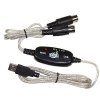As it's my first post in here, I would like to welcome all of you.
Before I start, I have to mention I'm amateur - not a pro, so please forgive me if any of my questions seems naive to people with a lot of experience.
One of my keyboards, PSR E323 was planned to use as "MIDI player" - of course not only for this, but I do really like listen MIDI playing from keyboard itself. Please don't be mislead as another keyboard (443) is located in my other home, far far away, and now I want to focus on 323.
I knew, as manual says:
I was planning to use this cable only to transfer MIDI files into keyboard and play them. As I failed, I thought I may be able to use this cable and use my 323 as MIDI keyboard, but despite many trials, using various software and platforms (PC / Mac) data being send from keyboard to computer is not exactly what I'm playing. Could anyone explain for me why this is happening?
I understand, buying UX16 cable will solve everything, but the cheapest one, I can find costs £49.99 and I can't really afford it, as I paid for my E323 £40.
I read about "power button" and it looks like it's common problem when pressing to turn on keyboard, it takes a while, display is flashing and eventually keyboard starts. I can't turn it off using power button.
I have this problem two or three years already, and I can live with that - but if there's a solution (simple one) I will be happy to know the answer. And finally most important question will power button problem will cause (eventually) more major problems, or this problem is stand alone and shouldn't affect anything else.
I will really appreciate your help. Thank you in advance.

Before I start, I have to mention I'm amateur - not a pro, so please forgive me if any of my questions seems naive to people with a lot of experience.
One of my keyboards, PSR E323 was planned to use as "MIDI player" - of course not only for this, but I do really like listen MIDI playing from keyboard itself. Please don't be mislead as another keyboard (443) is located in my other home, far far away, and now I want to focus on 323.
I knew, as manual says:
I thought, as this manual has many years, now I will be able to buy any cable and problem solved. I bought cheap cable (attachment) and as you probably already knew it, it's not working."A Yamaha UX16 or similar USB-MIDI interface (sold separately) will be necessary for MIDI connection between the PSR-E323/YPT-320 and a USB-equipped computer."
I was planning to use this cable only to transfer MIDI files into keyboard and play them. As I failed, I thought I may be able to use this cable and use my 323 as MIDI keyboard, but despite many trials, using various software and platforms (PC / Mac) data being send from keyboard to computer is not exactly what I'm playing. Could anyone explain for me why this is happening?
I understand, buying UX16 cable will solve everything, but the cheapest one, I can find costs £49.99 and I can't really afford it, as I paid for my E323 £40.
I read about "power button" and it looks like it's common problem when pressing to turn on keyboard, it takes a while, display is flashing and eventually keyboard starts. I can't turn it off using power button.
I have this problem two or three years already, and I can live with that - but if there's a solution (simple one) I will be happy to know the answer. And finally most important question will power button problem will cause (eventually) more major problems, or this problem is stand alone and shouldn't affect anything else.
I will really appreciate your help. Thank you in advance.


